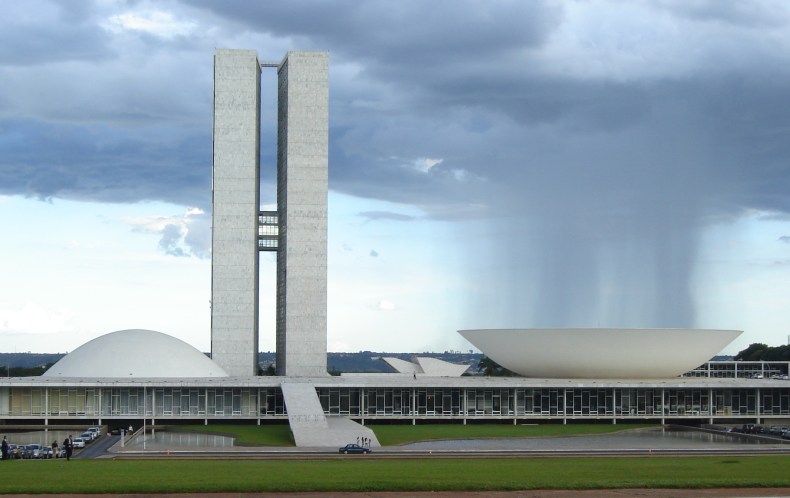‘After Rio, all other cities seem drab, the people in the streets monotonous, life too neat and uniform,’ wrote Stefan Zweig in 1941. The builders of Brasília in the decade that followed would have done well to heed his words. Yet even they do not come close to capturing the frigid, monumental emptiness of the place that in 1960 dislodged Rio as Brazil’s capital. The city Brasília supplanted has never recovered from the shock and humiliation of its demotion. ‘What state is Rio left in?’ asked a newspaper at the time. ‘Divorced, repudiated, simply abandoned after two centuries of marriage.’
Shortly after his election as president in 1955, Juscelino Kubitschek decided to give the nation a capital that would lend concrete form to the perennial claim that Brazil was the ‘country of tomorrow’. The site chosen represented a conscious rejection of Brazil’s past: a barren, semi-arid plateau in the centre of the country, a thousand kilometres or more from Rio and the other coastal cities that had formed the locus of Brazilian civilisation since the 16th century. In this quasi-Martian wilderness, Kubitschek commissioned the urban planner Lúcio Costa and the architect Oscar Niemeyer to produce a metropolis of the future.
The Monumental Axis in Brasília, seen from the TV tower. Photo: Cayambe/Wikimedia Commons (used under Creative Commons licence [CC. BY 3.0])

In other countries, tyrants build cities in their own images. In Brazil, an elected government created a turnkey capital for a dictatorship. And so it came to pass. In 1964, four years after Brasília’s inauguration, the army overthrew Kubitschek’s successor-but-one, João Goulart, and instituted two decades of military rule. In Rio, there was noisy and continuous resistance to the military takeover. In faraway Brasília, Congress nodded through Goulart’s deposition and welcomed the generals into Niemeyer’s presidential palace. The new leaders of Brazil discovered in the capital an ideal place for the kind of government they sought to impose. It was far from the madding crowd of Rio. The wide boulevards were tailor-made for military parades. The columns of identikit ministries lining the Monumental Axis seemed to embody the new regime’s promise of order. The glass exterior of the presidential palace was suggestive not so much of official transparency as of the all-seeing power of the state. Brasília came to be, in the words of one commentator, a ‘city without public opinion’.
National Congress Building in Brasília, designed by Oscar Niemeyer and completed in 1960. Photo: Eurico Zimbres/Wikimedia Commons (used under Creative Commons licence [CC. BY 2.5])

The corollary of Kubitschek’s policy has been the hollowing out of Rio. On the eve of the transfer, Rio was, in the words of the author Joaquim Ferreira dos Santos, ‘a charming and amusing party, with its mixture of politicians, beautiful women, intellectuals and young people’. The politicians – for all the opprobrium heaped on them – were an essential ingredient, with a natural interest in maintaining and improving the city that was home to them and Brazil’s window to the world. The removal of the politicians meant the removal of patronage. After 1960, manufacturers were encouraged to relocate inland, bringing deindustrialisation and unemployment. The city’s autonomy was weakened by a vindictive dictatorship, which in 1975 authorised the demolition of the historic Palácio Monroe, the former seat of the Senate and a triumph of eclecticism. Between 1960 and 2010, the proportion of the city’s residents living in favelas more than doubled. Rio now boasts the largest slum population of any Brazilian conurbation. As these ungoverned spaces grew, they fell into the hands of criminal gangs, which to this day rule much of Rio by Kalashnikov.
The daily stories of unfinished facilities, creaking infrastructure, and violent robberies in Rio on the eve of the Olympics are the fruits not of poor organisation or planning, but of decades of neglect and underinvestment. The much-vaunted Olympic ‘legacy’ will be hard to come by once the circus leaves town. There is one way in which the government can make amends: by restoring Rio to its place as Brazil’s capital.



